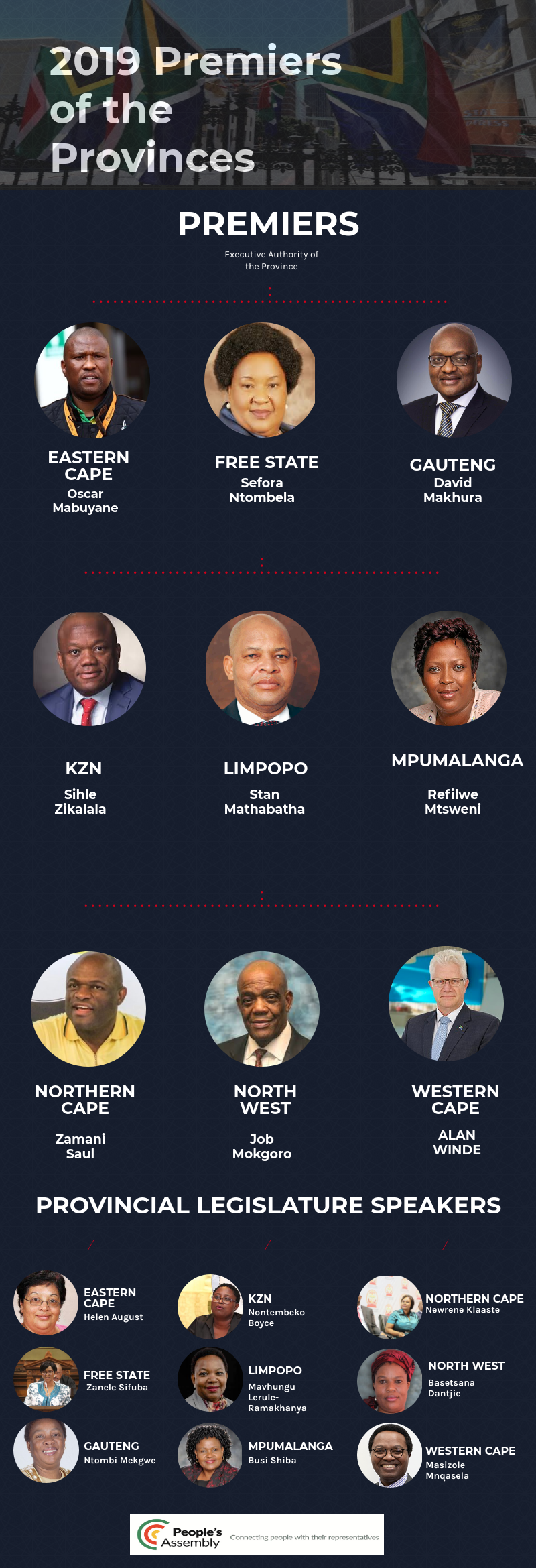Last week, Wednesday 22 May 2019, Members of the Provincial Legislatures (MPLs) were sworn in. Presided over by the Judge Presidents for each province, the nine provincial legislatures also elected the Premiers of the province and Speakers and Deputy Speakers of the legislatures. The Premiers were inaugurated on 27 May 2019. You can find the political party representation on each of the legislatures here.
Provincial Legislatures
The Constitution outlines in Chapter 6 that the legislative authority of a province is vested in its provincial legislature. A province’s permanent delegates to the NCOP may attend and may speak in the provincial legislatures and its committees, but may not vote – the NCOP is constitutionally mandated to ensure provincial interests are taken into account in the national sphere of government. Each province sends 10 delegates to permanently represent the province in the national legislature. The NCOP is thus composed of 90 delegates. A provincial delegation consists of 6 permanent delegates and 4 special delegates. The four special delegates consist of the Premier of the province and three other special delegates assigned from members of the provincial legislature. They are selected by each province from Members of the Provincial Legislature (MPLs) and are rotated depending on the subject matter being considered by the NCOP. The Premier of a province is the head of the province’s delegation but he or she can select any other delegate to lead the delegation in his or her absence.
In terms of powers, the provincial legislature may:
-
Consider, pass, amend or reject any Bill before the legislature
-
Initiate or prepare legislation, except Money Bills
-
Ensure all provincial organs of state in the province are accountable to it
-
Maintain oversight of the (1) exercise of provincial executive authority in the province, including implementation of legislation and (2) any provincial organ of state
The size of each provincial legislature depends on the population size of the province. According to the Constitution the minimum size of a Legislature is 30 members and the maximum size is 80 members. Members are elected from provincial lists on the basis of the number of votes received by a political party.
Premiers
The Constitution outlines in Chapter 6 that the executive authority of a province is vested in the Premier of that province. The Premier exercises the executive authority together with the other Members of the Executive Council (MECs) by (1) implementing all provincial legislation in the province and (2) implementing all national legislation within the functional areas listed in Schedule 4 or 5 except where the Constitution or an Act of Parliament provides otherwise (3) administering in the province, national legislation outside the functional areas listed in Schedules 4 and 5, the administration of which has been assigned to the provincial executive in terms of an Act of Parliament () developing and implementing provincial policy (5) coordinating the functions of the provincial administration and its departments (6) preparing and initiating provincial legislation (7) performing any other function assigned to the provincial executive in terms of the Constitution or an Act of Parliament
The Premier of a province has the power to:
-
Assent and sign Bills
-
Refer a Bill back to the provincial legislature for reconsideration of the Bill’s constitutionality
-
Refer a Bill to the Constitutional Court for a decision on the Bill’s constitutionality
-
Summoning the legislature to an extraordinary sitting to conduct special business
-
Appoint commissions of inquiry
-
Call a referendum in the province in accordance with national legislation



Comments
Keep comments free of racism, sexism, homophobia and abusive language. People's Assembly reserves the right to delete and edit comments
(For newest comments first please choose 'Newest' from the 'Sort by' dropdown below.)